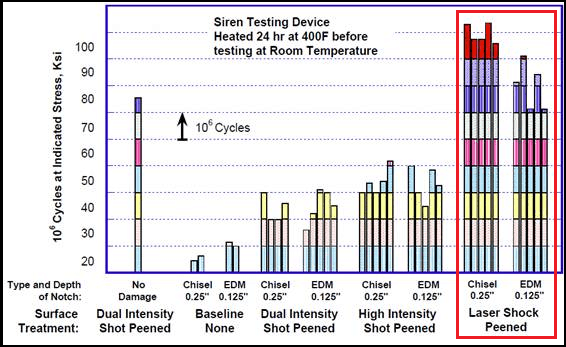Laser Peening Prevents Engine Blade Damage in Aircraft
The Air Force turned to laser peening as a potential solution to improve the durability of F101 fan blades and decrease the blades' sensitivity to FOD.
Posted: October 7, 2019
By: Mohammad n/a
Engine Blade Damage
In 1991, the B-1B Lancer’s F101 engine began experiencing titanium turbine blade failures that forced the grounding of the entire B-1 fleet. The primary hazard was foreign object damage (FOD), as ingested ice chunks and other hard objects were producing cracks in the blades that led to failure and irreparable engine damage.
-

B-1B Lancer
The Challenge
The United States Air Force ordered special manual inspections prior to all B-1 flights, a laborious procedure that involved rubbing the leading edge of each blade with cotton balls, cotton gloves, or dental floss. If inspectors detected even a single snag, the blade was swapped out and replaced before the aircraft was cleared to fly. By 1994, the Air Force was devoting over one million man-hours at a cost of $10 million per year to complete the engine inspections and keep the B-1 flying.
- Increase fatigue life for engine fan blades
- Reduce costs of engine inspections
- Reduce the downtime of the B-1
The Solution
The Air Force turned to laser peening as a potential solution to improve the durability of F101 fan blades and decrease the blades’ sensitivity to FOD. They tested laser peening on blades that were nothced up to 0.25 inches deep to simulate foreign object damage. The blades were subjected to rigorous fatigue testing, and their performance was compared to similarly notched blades that had only been shot peened. The fatigue life improvement for laser peened blades was unprecedented.
Damage to a typical F101 blade reduces the fatigue strength from 75 ksi to less than 20 ksi – well below the design requirement. However, when laser peened blades are comparably damaged, they retain a fatigue strength of 75 ksi or more. Laser peened blades in the study outperformed shot peened blades by a wide margin, and even lasted longer than pristine, undamaged blades.
The Results

Given the overwhelming fatigue life improvement demonstrated by laser peening, the Air Force authorized production development of this revolutionary surface enhancement process. The Air Force began laser peening all F101 first stage fan blades in 1997, using four laser peening systems designed and built by LSP Technologies, Inc.
- Eliminated sensitivity to FOD defects up to 0.25in deep
- Prevented engine failure for critical aircraft and crew
Laser peening adoption proved to be a valuable application for the U.S. Air Force, with tens of millions of dollars saved in blade replacement costs, engine damage repair costs, inspection and maintenance, and cost avoidance from airfoil failures.
Overall, the potential savings offered by laser peening are estimated to approach $1 billion when calculated over all engines in the Air Force fleet.
Interested in Seeing More?
Tell us about your application, material, or failure mechanism and we will have one of our experts reach out to you. Our extensive library of research and years of experience gives us a unique advantage to apply a finite element analysis to help diagnose the best application for your situation.
